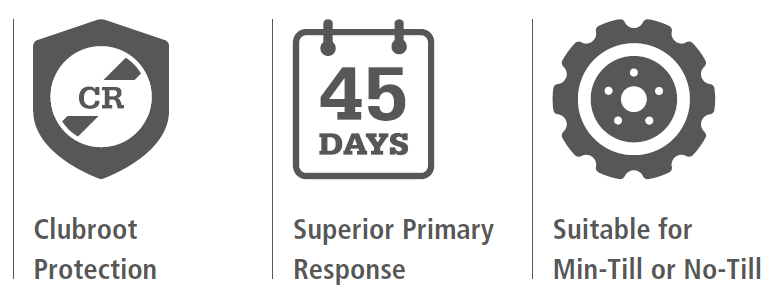Profile
Status: AHDB Recommended List 2026/27
Not only has CROCODILE CR closed the gap between clubroot resistant varieties and ‘normal’ varieties, in many cases it is actually out-yielding them! As clubroot infection rates appear to indicate that the disease is continuing to spread south, CROCODILE CR offers growers a valuable, high yielding option as part of their crop rotation on land where common strains of clubroot are known to be an issue.
CROCODILE CR is recommended for use on clubroot infected land. It is a strong yielding variety on the AHDB List (Gross Output E/W – 99% and Seed Yield E/W – 99%) which also scoring well for oil content (44.8%). It has a strong score for Light Leaf Spot (6) and good standing power.
At DSV we always aim to deliver yield with traits rather than traits at the expense of yield. Clubroot has become more apparent on farm during the last five years, with closer rotations, meaning it is often costly and hard to control.
Alongside clubroot resistant varieties it is also important to consider other factors such as the PH of the soil should PH 7 or above, and calcium can be added, lengthening rotations, and consideration can be given to the eradication of brassica weeds, such as runch and charlock which can amplify the problem.
CROCODILE CR may, however, be infected by certain strains and infections that have been reported in some fields. Early drilling is not advised as this can put pressure on the protection. DSV recommends Clubroot tolerant varieties such as Crocodile CR and Crossfit CR should be grown in a 1 in 5 rotation to protect their resistance mechanisms any closer rotation could increase the chances of a breakdown.
It is important that growers protect the clubroot genetics by only planting the variety where clubroot is known to be an issue. Due to the rapid development of the lower branches of CROCODILE CR, DSV recommends a sowing rate of 40 – 50 seeds per m2 and a PGR in spring is only required on fertile sites to ensure efficient harvestability. Its vigorous autumn growth allows it to be drilled over a broad range of dates without any issues.
-
 Closes the gap between clubroot resistant varieties and ‘normal’ varieties
Closes the gap between clubroot resistant varieties and ‘normal’ varieties
-
 Highest yielding Clubroot variety on Recommended List
Highest yielding Clubroot variety on Recommended List
-
 Good standing power
Good standing power
Yield information

| Gross Output – United Kingdom (%) | 95 | |
|---|---|---|
| Gross Output – East / West region (%) | 96 | |
| Seed yield - United Kingdom (%) | 95 | |
| Seed yield - East / West region (%) | 96 | |
| Untreated gross output UK (%) | 98 | |
| Untreated seed yield UK (%) | 98 | |
| Oil content (%) | 45.5 | |
| Gross Output – United Kingdom (%) | 95 | |
|---|---|---|
| Gross Output – East / West region (%) | 96 | |
| Seed yield - United Kingdom (%) | 95 | |
| Seed yield - East / West region (%) | 96 | |
| Untreated gross output UK (%) | 98 | |
| Untreated seed yield UK (%) | 98 | |
| Oil content (%) | 45.5 | |
Assessments

| Autumn vigour |
+
+
+
|
|---|---|
| Spring vigour |
+
+
+
|
| Winter hardness |
+
+
+
|
|
Autumn vigour
+
+
+
|
|
Spring vigour
+
+
+
|
|
Winter hardness
+
+
+
|
Agronomics Features

| Resistance to lodging |
8
|
strong to very strong |
|---|---|---|
| Stem Stiffness |
8
|
strong to very strong |
| Shortness of stem |
6
|
medium to tall |
| Beginning of flowering |
7
|
late |
| Maturity |
6
|
medium to late |
| Resistance to light leaf spot |
6
|
medium to high |
| Resistance to stem canker |
4
|
low to medium |
Source: AHDB Recommended List 2026/27 | () = Breeder classification
|
Resistance to lodging
8
|
||
|
Stem Stiffness
8
|
||
|
Shortness of stem
6
|
||
|
Beginning of flowering
7
|
||
|
Maturity
6
|
||
|
Resistance to light leaf spot
6
|
||
|
Resistance to stem canker
4
|
Source: AHDB Recommended List 2026/27 | () = Breeder classification
